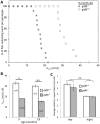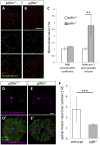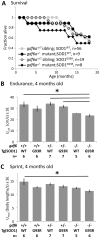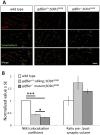Growth differentiation factor 6 as a putative risk factor in neuromuscular degeneration
- PMID: 24586579
- PMCID: PMC3938462
- DOI: 10.1371/journal.pone.0089183
Growth differentiation factor 6 as a putative risk factor in neuromuscular degeneration
Abstract
Mutation of Glass bottom boat, the Drosophila homologue of the bone morphogenetic protein or growth/differentiation factor (BMP/GDF) family of genes in vertebrates, has been shown to disrupt development of neuromuscular junctions (NMJ). Here we tested whether this same conclusion can be broadened to vertebrate BMP/GDF genes. This analysis was also extended to consider whether such genes are required for NMJ maintenance in post-larval stages, as this would argue that BMP genes are viable candidates for analysis in progressive neuromuscular disease. Zebrafish mutants harboring homozygous null mutations in the BMP-family gene gdf6a were raised to adulthood and assessed for neuromuscular deficits. Fish lacking gdf6a exhibited decreased endurance (∼ 50%, p = 0.005) compared to wild type, and this deficit progressively worsened with age. These fish also presented with significantly disrupted NMJ morphology (p = 0.009), and a lower abundance of spinal motor neurons (∼ 50%, p<0.001) compared to wild type. Noting the similarity of these symptoms to those of Amyotrophic Lateral Sclerosis (ALS) model mice and fish, we asked if mutations in gdf6a would enhance the phenotypes observed in the latter, i.e. in zebrafish over-expressing mutant Superoxide Dismutase 1 (SOD1). Amongst younger adult fish only bigenic fish harboring both the SOD1 transgene and gdf6a mutations, but not siblings with other combinations of these gene modifications, displayed significantly reduced endurance (75%, p<0.05) and strength/power (75%, p<0.05), as well as disrupted NMJ morphology (p<0.001) compared to wild type siblings. Bigenic fish also had lower survival rates compared to other genotypes. Thus conclusions regarding a role for BMP ligands in effecting NMJ can be extended to vertebrates, supporting conservation of mechanisms relevant to neuromuscular degenerative diseases. These conclusions synergize with past findings to argue for further analysis of GDF6 and other BMP genes as modifier loci, potentially affecting susceptibility to ALS and perhaps a broader suite of neurodegenerative diseases.
Conflict of interest statement
Figures





Similar articles
-
A genetic model of amyotrophic lateral sclerosis in zebrafish displays phenotypic hallmarks of motoneuron disease.Dis Model Mech. 2010 Sep-Oct;3(9-10):652-62. doi: 10.1242/dmm.005538. Epub 2010 May 26. Dis Model Mech. 2010. PMID: 20504969 Free PMC article.
-
Neuromuscular effects of G93A-SOD1 expression in zebrafish.Mol Neurodegener. 2012 Aug 31;7:44. doi: 10.1186/1750-1326-7-44. Mol Neurodegener. 2012. PMID: 22938571 Free PMC article.
-
Axonal degeneration, distal collateral branching and neuromuscular junction architecture alterations occur prior to symptom onset in the SOD1(G93A) mouse model of amyotrophic lateral sclerosis.J Chem Neuroanat. 2016 Oct;76(Pt A):35-47. doi: 10.1016/j.jchemneu.2016.03.003. Epub 2016 Mar 30. J Chem Neuroanat. 2016. PMID: 27038603
-
Neuromuscular junction destruction during amyotrophic lateral sclerosis: insights from transgenic models.Curr Opin Pharmacol. 2009 Jun;9(3):341-6. doi: 10.1016/j.coph.2009.03.007. Epub 2009 Apr 20. Curr Opin Pharmacol. 2009. PMID: 19386549 Review.
-
Transgenic mouse model for familial amyotrophic lateral sclerosis with superoxide dismutase-1 mutation.Neuropathology. 2001 Mar;21(1):82-92. doi: 10.1046/j.1440-1789.2001.00361.x. Neuropathology. 2001. PMID: 11304046 Review.
Cited by
-
A low affinity cis-regulatory BMP response element restricts target gene activation to subsets of Drosophila neurons.Elife. 2020 Oct 30;9:e59650. doi: 10.7554/eLife.59650. Elife. 2020. PMID: 33124981 Free PMC article.
-
gdf6a is required for cone photoreceptor subtype differentiation and for the actions of tbx2b in determining rod versus cone photoreceptor fate.PLoS One. 2014 Mar 28;9(3):e92991. doi: 10.1371/journal.pone.0092991. eCollection 2014. PLoS One. 2014. PMID: 24681822 Free PMC article.
-
A case report of amyotrophic lateral sclerosis in a patient with Klippel-Feil syndrome—a familial occurrence: a potential role of TGF-β signaling pathway.Medicine (Baltimore). 2015 Jan;94(4):e441. doi: 10.1097/MD.0000000000000441. Medicine (Baltimore). 2015. PMID: 25634178 Free PMC article.
-
Rapid Recovery of Visual Function Associated with Blue Cone Ablation in Zebrafish.PLoS One. 2016 Nov 28;11(11):e0166932. doi: 10.1371/journal.pone.0166932. eCollection 2016. PLoS One. 2016. PMID: 27893779 Free PMC article.
-
Bone morphogenetic protein signaling in vertebrate motor neurons and neuromuscular communication.Front Cell Neurosci. 2015 Jan 27;8:453. doi: 10.3389/fncel.2014.00453. eCollection 2014. Front Cell Neurosci. 2015. PMID: 25674047 Free PMC article. Review.
References
-
- McCabe BD, Marques G, Haghighi AP, Fetter RD, Crotty ML, et al. (2003) The BMP homolog Gbb provides a retrograde signal that regulates synaptic growth at the Drosophila neuromuscular junction. Neuron 39: 241–254. - PubMed
-
- Ruschke K, Hiepen C, Becker J, Knaus P (2012) BMPs are mediators in tissue crosstalk of the regenerating musculoskeletal system. Cell Tissue Res 347: 521–544. - PubMed
Publication types
MeSH terms
Substances
Grants and funding
LinkOut - more resources
Full Text Sources
Other Literature Sources
Molecular Biology Databases
Miscellaneous

